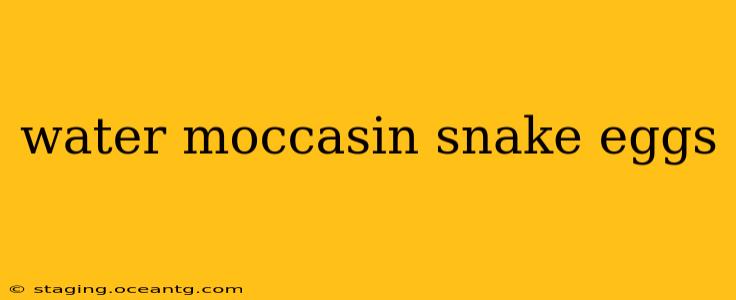Water moccasins, also known as cottonmouths, are venomous snakes that inhabit wetlands across the southeastern United States. Understanding their reproductive habits, including their eggs, is crucial for both researchers and those who live in their habitat. This comprehensive guide delves into the fascinating world of water moccasin snake eggs, answering many frequently asked questions.
What do water moccasin eggs look like?
Water moccasin eggs are typically white or cream-colored and leathery in texture. They are oval-shaped and relatively large compared to the eggs of some other snake species. The size can vary depending on the mother snake's size and overall health, but they generally measure around an inch or slightly more in length. Unlike some snakes that lay eggs in clutches, water moccasins can sometimes lay eggs singly or in small clusters.
Where do water moccasins lay their eggs?
Cottonmouths prefer to lay their eggs in moist, sheltered locations close to the water's edge. These locations often include:
- Dense vegetation: Thickets of plants provide concealment and protection from predators.
- Under logs and debris: These offer a damp, dark environment ideal for incubation.
- Hollows in the ground: Burrows or other natural cavities provide similar protection and moisture.
- Root systems of trees: The tangled roots of trees near water sources are also frequently used.
The exact location chosen depends largely on the availability of suitable sites within the snake’s territory.
How many eggs does a water moccasin lay?
The clutch size of water moccasin eggs can range significantly. On average, a female cottonmouth will lay between 6 and 20 eggs. However, this number can fluctuate depending on the age and health of the female and the availability of resources. Larger, more mature females generally lay larger clutches.
How long does it take for water moccasin eggs to hatch?
The incubation period for water moccasin eggs varies depending on environmental factors, primarily temperature and humidity. Typically, it takes between 6 and 10 weeks for the eggs to hatch. Warmer temperatures generally result in faster incubation times.
Are water moccasin eggs venomous?
No, water moccasin eggs themselves are not venomous. The venom is produced within the mother snake's venom glands and is transferred to the young through the yolk sac during development. However, it's crucial to remember that newly hatched water moccasins are already venomous.
What are the predators of water moccasin eggs?
Water moccasin eggs face predation from a variety of animals, including:
- Raccoons: These highly adaptable mammals are skilled at locating and consuming eggs.
- Opossums: Similar to raccoons, opossums are opportunistic feeders that prey on eggs.
- Other snakes: Some snake species are known to feed on the eggs of other snakes.
- Birds: Certain bird species, particularly those with ground-foraging habits, might prey on exposed eggs.
The survival rate of water moccasin eggs largely depends on the effectiveness of the nesting site in providing protection from these predators.
How can you identify a water moccasin egg?
Identifying a water moccasin egg definitively in the wild can be challenging. Unless you're an experienced herpetologist, it's difficult to differentiate them from the eggs of other similar-sized snakes. It's vital to remember that disturbing snake nests is not recommended.
What should you do if you find a water moccasin egg?
If you encounter what you suspect to be a water moccasin egg, the best course of action is to leave it undisturbed. Do not attempt to handle or relocate the eggs. Contact a local wildlife agency or herpetologist if you have concerns or need further information. Their expertise will help ensure the safety of both the eggs and yourself.
This guide provides a comprehensive overview of water moccasin snake eggs. Remember, responsible observation and respect for wildlife are essential when encountering these fascinating creatures and their offspring. Always prioritize safety and avoid direct interaction with venomous snakes.
